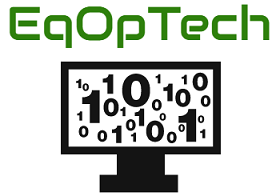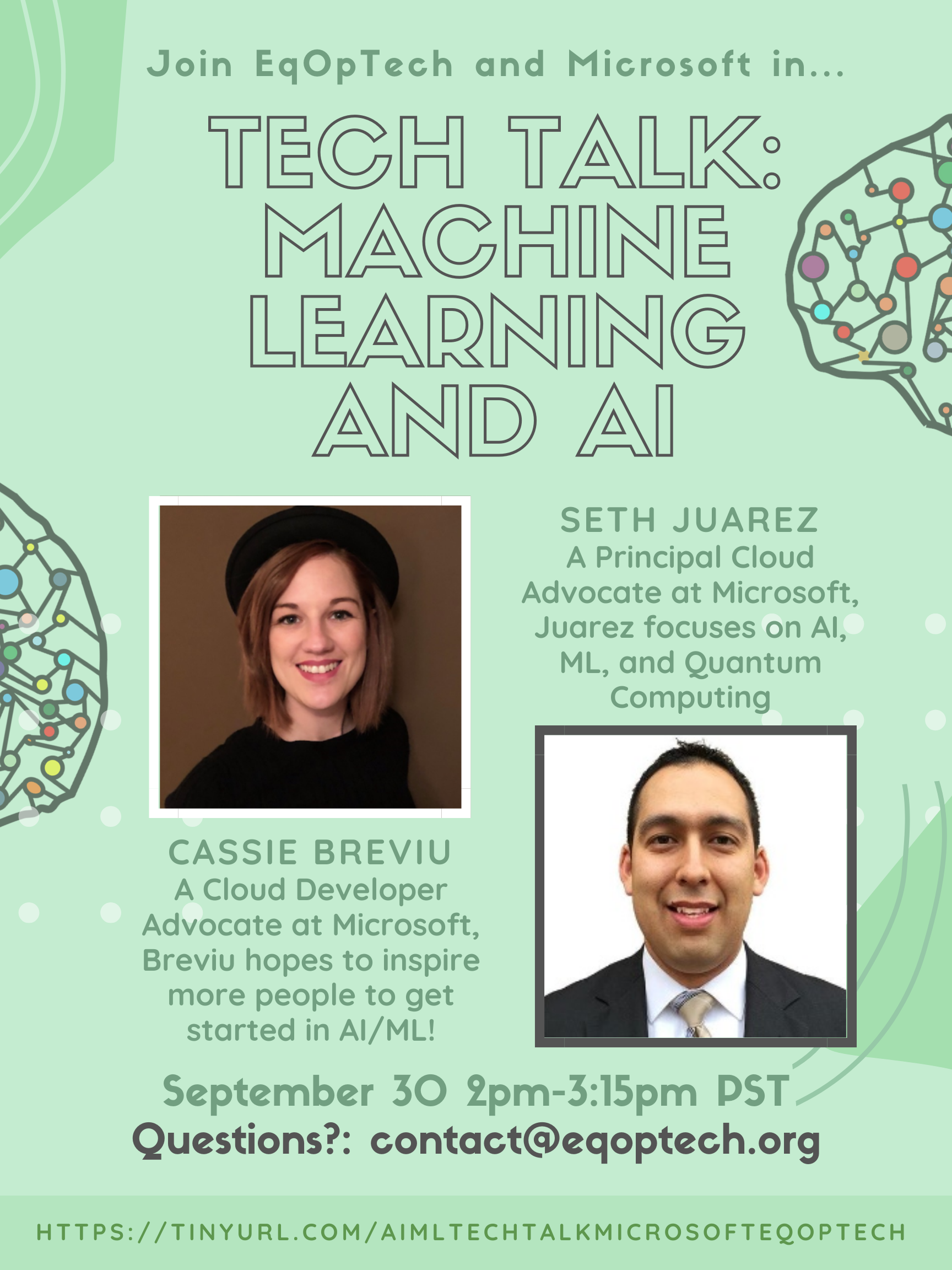By Alice Liu
On September 30th, 2020, Microsoft and EqOpTech hosted a virtual Tech Talk on Machine Learning (ML) and Artificial Intelligence (AI) with Microsoft. The speaker panel featured Cassie Breviu and Seth Juarez. Breviu is a Cloud Developer Advocate at Microsoft who focuses on AI. Having a non-traditional background without prior experience in AI, Breviu got herself more immersed and experienced in the field by teaching herself how to code using Excel macros. Later on, Breviu went into .NET software engineering – working a lot with web applications and business process applications. From there, she got more interested in ML and started to teach herself that. Juarez helps lead the efforts for AI and ML for Microsoft Advocacy developer relations. He previously did research in natural language processing and was a graduate student at the University of Utah studying Computer Science.
Cloud Development Advocacy
Juarez kicked off the presentation explaining what advocacy is. The mission of Cloud Developer Advocacy is “to empower every person and every organization to be successful with AI, ML, and Quantum in the cloud”. This is achieved primarily through the creation of content – which can be interpreted as anything, such as a TikTok video or a blog post. This content helps empower people to be successful in utilizing AI, ML, and Quantum in the cloud. “It’s a ton of different stuff that we make,” Juarez says. He specializes in creating stories around technology and delivers talks on the technology built. Along those lines, a lot of what Breviu has been doing involves building different AI models and figuring out how to solve something. Right now, she is learning about audio processing with ML, something that combines two of her passions: programming and music. “I’ll generally write a blog post or a talk and then I’ll go and I’ll kind of share how I did that and how I maybe leveraged Azure, how I broke apart the data, and basically share whatever I’ve learned and built with people,” Breviu says. The first thing Cloud Developer Advocates do, explains Juarez, is “create content and what we try to do is we try to tell stories with the things that we build.”
At times, as products are being built, the content and stories told about that product don’t really match up with the reality of the product. That’s when refining products comes into play. Cloud Developer Advocates meet with the product groups weekly and receive scenarios that they have to create content for. While doing so, the advocates will submit feedback to the product groups for their products and meet to discuss them. Juarez describes advocates as “the first line of defense” for putting out each product.
The third thing that Cloud Developer Advocates do is grow community. That community for the advocates is usually people interested in AI. Juarez describes this whole thing as a cycle of content, feedback, and community growth.
Machine Learning - “Rock Paper Scissors”
In regards to ML, Juarez describes it as “you [giving] it the answers and the input and it figures out how to solve the problem.” He did a live demonstration of this using rock, paper, scissors. Using code that he already made, Juarez holds his hand up to the camera in the typical shapes for rock, paper, and scissors. In response to this, the program identifies his hand shapes as either rock, paper, or scissors. Every time the program gets “confused” as to what he’s displaying, Juarez clicks on buttons labeled either rock, paper, or scissors in order to “feed” it more examples of what a rock, paper, or scissors looks like. “Machine learning is the process where we give the machine examples of the right thing and it figures it out,” Juarez says.
The service he uses for this is Custom Vision – which Microsoft provides. Using Custom Vision and the examples given to it, Juarez can train the model for accuracy. He says that “all of machine learning forces you to put things into what is called vector space, and then you do basically linear algebra and calculus over it.” Breviu says that “the inferencing takes a lot less resources than the training and so the training is not happening locally on this machine; it's happening in the cloud using this tool and the inferencing he’s doing locally.” Breviu also suggests Custom Vision as a great pre-built tool to use for learning more about building Custom Vision models.
A Goal To Build Something to Automate Laborious Tasks
When Breviu first got started in this field, she tried a lot of things. She thought that the hardest part was finding the first development role. “I find that sometimes smaller companies are easier to get started in,” Breviu says. At the time, she was a data analyst and had a lot of experience in Excel. Because the tasks were repetitive, Breviu decided to automate them. “I think the best way to learn and stay motivated is having a goal,” she says. For everything she wanted to build or learn, Breviu would set a goal for herself – not stopping until she got there. Breviu took some classes at a community college in order to learn more about the object-oriented aspects. In regards to being self-taught without a curriculum, Breviu says that “you don’t know what you don’t know” so being able to have different resources was really helpful for her.
To start with a goal in mind, Breviu recommends breaking it down into smaller steps and solving those individually. Breviu got involved in the tech field through working in tech support for a while and later moving into a business analyst position – helping design future upgrades. When it came to getting her first developer job, a recruiter called about quality assurance (QA) job and Breviu took the interview. She said that she was interested in being a developer but could also do (QA), so in a second interview they did more of a “developer interview”. Breviu ended up being QA for 3-4 months and moved into her developer role. “There’s so many different non-traditional paths,” Breviu says. “Once you get some of that experience, that’s when it becomes less important about your degree.” Although degrees and education are helpful in finding a job, most recruiters are looking for developers and aren’t necessarily looking at degrees or education, they’re focusing on experiences. Breviu says that she “learned a lot just by getting in the atmosphere”.
ML, AI and XR Opportunities in Education
The role ML and AI play in helping students learn and explore at home is a growing one, and Juarez suggests that one way these could be incorporated together is by training a model to check if a student is understanding a lesson during class by recognizing their facial expressions. Breviu thinks that education can become more revolutionized through XR, such as augmented reality (AR), virtual reality (VR), and more. “I see [VR] being a much bigger contributor to changing how we learn in a virtualized society,” Breviu says.
Overall, the panel discussed so much interesting and innovative information regarding ML and AI as well as their roles and applications in the real world. ML, AI, and so many other tools and technologies are on the rise in today’s society, especially in the classroom. During the current quarantine, schools are utilizing technology almost every day. ML, AI and XR technologies can revolutionize and transform future learning and teaching.
“A Big thank you to Microsoft Cloud Advocates for speaking and sharing knowledge and to Umayr Sufi, Development Specialist for organizing and hosting this informative speaker event!”
Microsoft ML/AI Speaker Event., Sept 30, 2020
EqOpTech Inc., located in Los Altos, CA, is a 501(c)(3) IRS-designated tax exempt nonprofit organization that promotes and enables equal opportunity free access to technology for computer learning and STEM education in under-served communities. Visit EqOpTech at www.EqOpTech.org
The Equal Opportunity Technology program is made possible thanks to the Los Altos Community Foundation community grant award. Visit here for more information.


